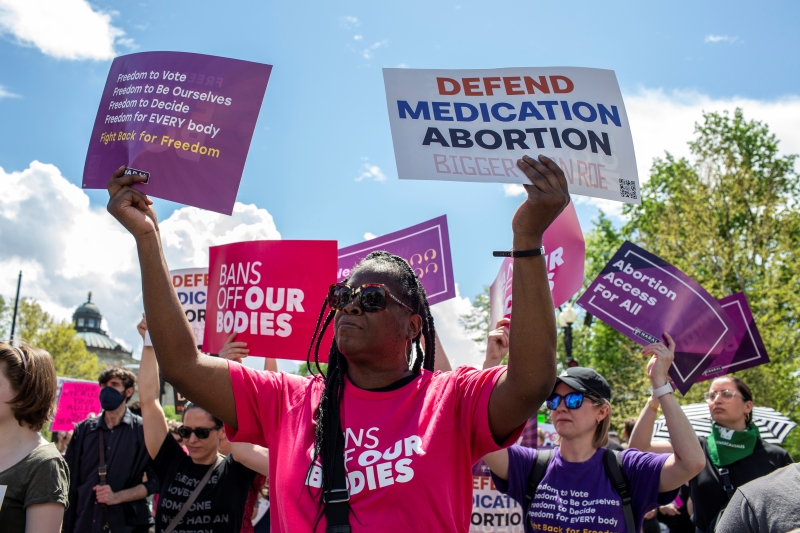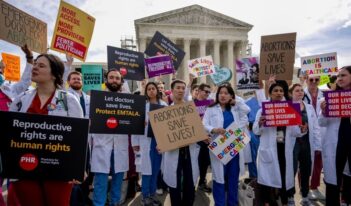
Political pressure and wary regulators shaped FDA’s mifepristone approval in 2000.
In November 2022, shortly after the U.S. Supreme Court overturned Roe v. Wade, anti-abortion activists filed a lawsuit against the U.S. Food and Drug Administration (FDA) in Amarillo, Texas, challenging the agency’s regulation of the abortion medication mifepristone. In Alliance for Hippocratic Medicine v. FDA, the plaintiffs argued that FDA had inappropriately rushed approval of the medication in 2000 without adequate evidence that the medication met the agency’s safety standards. They asked the court to remove mifepristone from the market nationwide.
My new book, Abortion Pills: US History and Politics, takes a deep dive into the history of FDA regulation of mifepristone and the political pressures the agency experienced in the 1990s and since while regulating mifepristone.
Political opposition to FDA approval of mifepristone was strong in the 1990s, both in Congress and in the anti-abortion movement. In 1998 and 1999, U.S. Representative Tom Coburn (R-Okla.) led the charge to stop FDA approval of mifepristone along with Representatives Chris Smith (R-N.J.) and Dave Weldon (R-Fla.). Conservative staffers formed the “Values Action Team” to coordinate efforts to stop the approval. Coburn even introduced an appropriations bill amendment to block the approval of the drug by FDA. Meanwhile, anti-abortion extremists threatened boycotts and violence against organizations and individuals involved with bringing the medication to the United States, including FDA. At the time of approval, FDA refused to reveal the names of the manufacturer or FDA employees involved in approving the drug, citing fear of anti-abortion violence. The threats were so serious that the agency had to increase security at its offices.
Because of these political pressures, when FDA approved mifepristone in 2000, it placed the medication under multiple extraordinary restrictions. Under a regulatory restriction called Subpart H, FDA prohibited retail pharmacies from stocking and distributing mifepristone, instead requiring that patients obtain mifepristone from an office, clinic, or hospital and a physician registered with the drug manufacturer. FDA required secure manufacturing, receiving, and holding areas for the drug, and secure shipping procedures, including tamper-proof seals, controlled returns procedures, a tracking system that could trace individual packages to a patient while maintaining patient confidentiality, and the use of authorized distributors with the necessary expertise to handle distribution requirements.
Contrary to the scientific evidence that demonstrated the safety of mifepristone, FDA required a black box warning on the package insert—the strongest warning that FDA requires—notifying consumers that medical studies indicated that the drug carried a significant risk of serious or even life-threatening adverse effects. FDA approved the use of mifepristone for only the first seven weeks of gestation and required the patient to make three office visits to obtain the medication.
FDA approved mifepristone pursuant to Subsection H so it could place restrictions on the medication and require post-marketing surveillance to establish that the safety results shown in clinical trials occurred in the much wider population.
Abortion rights supporters, such as The American College of Obstetricians and Gynecologists, opposed these restrictions as unnecessarily burdensome on patients and physicians. Abortion rights supporters also expressed frustrated that FDA insisted on the restrictions, but were also eager to obtain FDA approval before Republican George W. Bush became President in January of 2001.
Ironically, abortion opponents would later claim—in Alliance for Hippocratic Medicine v. FDA—that the agency used Subpart H to speed up approval of the drug and therefore the approval was invalid. They also argued that the Clinton Administration fast-tracked approval for mifepristone, causing FDA to ignore mifepristone’s risks. In fact, the process took years and the drug received considerably more scrutiny than was typical.
Many people have expressed their belief that FDA imposed these restrictions not because of concerns about the safety of mifepristone, but because of the politically volatile context and fear of violence. Eleanor Smeal, president of the Feminist Majority Foundation, which led a campaign in support of mifepristone, stated that FDA imposed the restrictions “to pacify the right-to-life movement in our country.” Others echoed this view, such as Beverly Winikoff at the Population Council, which sponsored the clinical trials and drug application. Winikoff stated that FDA staff members were “frozen with fear,” noting that FDA typically recorded detailed minutes of agency meetings with participants’ names listed, but it did not do so for mifepristone meetings, for fear that staff members working on the application would be revealed and endangered.
Winikoff described the precautions taken by FDA to protect people from anti- abortion violence during an FDA advisory board hearing on mifepristone in 1998.
We weren’t allowed to know where it would be. We were assigned to go to a gathering place, and then we were loaded into buses and then they took us there. It was all secret because they thought somebody would throw a bomb in it. It was unbelievable how they were just so scared. Everyone was scared.
Others agreed, such as Cynthia Pearson of the National Women’s Health Network.
FDA’s visceral fear of violence on that day was emblematic of their fear of all kinds of attacks. They had a specific fear around the day that they were going to be meeting publicly to discuss it, but they also feared that they would be attacked by Congress and take a lot of criticism for approving the abortion pill.
Asked whether she thought that was why FDA put mifepristone under so many restrictions, Pearson responded, “I know it is,” citing conversations she later had with Dr. Philip Corfman, the executive secretary of the Obstetrics, Reproductive and Urologic Drugs Advisory Committee within the FDA. Pearson credited Corfman with guiding mifepristone “through a complex and politically charged approval process.”
On the other hand, Kirsten Moore, who was at the Reproductive Health Technologies Project at the time and later worked to loosen FDA restrictions with the EMMA Project, remarked that FDA restrictions on mifepristone had more to do with the conservative and bureaucratic nature of FDA.
Everybody assumes there was political pressure. I don’t think that’s the case here. They are bureaucrats. They get very conservative and cautious. They aren’t regular abortion providers. This is an unknown world for them. They’re a little freaked out by it, and they’re like, “Oh, we have to put as many belts and suspenders around this as we can because it’s abortion.” It’s not a part of mainstream health care. People don’t have experience doing it. They imagine the worst and that’s what they then regulate against.
When FDA approved mifepristone, Amy Allina of the National Women’s Health Network explained that “the entire process of bringing mifepristone to the United States was politically constrained. There was no piece of it that happened without a high level of awareness that it was politically fraught. It was the agency trying to stay out of the political line of fire.” Allina stated that FDA was as cautious as possible while “still getting to the outcome of approving a drug that clearly had a track record that merited approval.”
Based on interviews with over 80 medical researchers, policy experts, and public health advocates, Abortion Pills: US History and Politics gives much-needed context to the FDA approval process for mifepristone as well as the agency’s subsequent regulation of the medication over the following decades. In a second Trump Administration, questions of mifepristone regulation will remain on the public agenda, making this history an important background for evaluating claims made in legal and policy contexts.
Professor Baker’s new book, Abortion Pills: U.S. History and Politics, is available open access from Amherst College Press.




